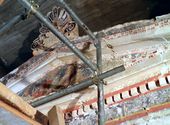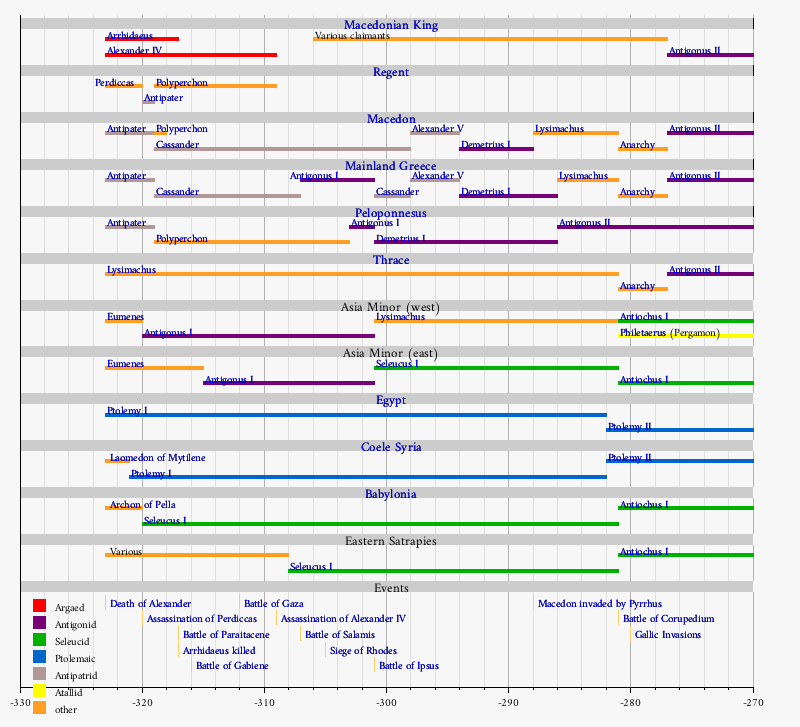مقدونيا (مملكة قديمة)
(تم التحويل من مقدون)
Macedonia Μακεδονία | |||||||||||||||||||||||
|---|---|---|---|---|---|---|---|---|---|---|---|---|---|---|---|---|---|---|---|---|---|---|---|
| |||||||||||||||||||||||
 | |||||||||||||||||||||||
 The Kingdom of Macedonia in 336 BC (orange) | |||||||||||||||||||||||
| العاصمة |
| ||||||||||||||||||||||
| اللغات الشائعة | Ancient Macedonian, Attic Greek, Koine Greek | ||||||||||||||||||||||
| الدين | Greek polytheism, Hellenistic religion | ||||||||||||||||||||||
| الحكومة | Monarchy | ||||||||||||||||||||||
| King | |||||||||||||||||||||||
• 808–778 BC | Caranus (first) | ||||||||||||||||||||||
• 179–168 BC | Perseus (last) | ||||||||||||||||||||||
| التشريع | Synedrion | ||||||||||||||||||||||
| الحقبة التاريخية | Classical Antiquity | ||||||||||||||||||||||
| 808 BC | |||||||||||||||||||||||
| 512/511–493 BC | |||||||||||||||||||||||
| 492–479 BC | |||||||||||||||||||||||
| 359–336 BC | |||||||||||||||||||||||
| 338–337 BC | |||||||||||||||||||||||
| 335–323 BC | |||||||||||||||||||||||
| 323 BC | |||||||||||||||||||||||
| 168 BC | |||||||||||||||||||||||
| Area | |||||||||||||||||||||||
| 323 BC[4][5] | 5،200،000 km2 (2،000،000 sq mi) | ||||||||||||||||||||||
| Currency | Tetradrachm | ||||||||||||||||||||||
| |||||||||||||||||||||||
مقدون بالإنجليزية: Macedon or Macedonia باليونانية: Μακεδονία Makedonía ، هي مملكة قديمة شملت معم الجزء الشمالي من بلاد اليونان القديمة. يحدها من الغرب مملكة إيبرس وإقليم تراقيا من الشرق. أصبحت مقدون في فترة وجيزة أقوى دولة في الشرق الأدنى القديم وخاصة بعد أن غزاها الإسكندر الأكبر.

خريطة توضح مملكة مقدون القديمة
التاريخ
الامبراطورية
Left, Bust of Alexander the Great by the Athenian sculptor Leochares, 330 BC, Acropolis Museum, Athens. Right, Bust of Alexander the Great, a Roman copy of the Imperial Era (1st or 2nd century AD) after an original bronze sculpture made by the Greek sculptor Lysippos, Louvre, Paris.

ممالك الديادوخي ح. 301 ق.م.، بعد معركة إپسوس
Kingdom of Ptolemy I Soter
Kingdom of Cassander
Kingdom of Lysimachus
Kingdom of Seleucus I Nicator
Other 
A golden stater of Philip III Arrhidaeus (ح. 323–317 BC) bearing images of Athena (left) and Nike (right)
العصر الهليني
The portrait busts of Pyrrhus of Epirus (top left), Demetrius I of Macedon (top right), Seleucus I Nicator (bottom left), and Lysimachus (bottom right), Roman-era copies of Hellenistic Greek originals from the Villa of the Papyri at Herculaneum, Naples National Archaeological Museum

Paintings of Hellenistic-era military arms and armor from a tomb in ancient Mieza (modern-day Lefkadia), Imathia, Central Macedonia, Greece, 2nd century BC
النزاع مع روما
[[File:Macedonia and the Aegean World c.200.png|thumb|400px|The Kingdom of Macedonia (orange) under Philip V
[[File:Philip V. 221-179 BCE.jpg|thumb|300px|left|A tetradrachm of Philip V of Macedon (ح. 221–179 BC), with the king's portrait on the obverse and Athena Alkidemos brandishing a thunderbolt on the reverse]]

Bronze bust of Eumenes II of Pergamon, a Roman copy of a Hellenistic Greek original, from the Villa of the Papyri in Herculaneum
المؤسسات
الرسل الملكيون
Left, the god Dionysos riding a cheetah, mosaic floor in the "House of Dionysos" at Pella, Greece, c. 330–300 BC. Right, a framentary votive relief depicting a youth ladling wine from a krater next to a round table with vases, from the agora of Pella, end of 4th century BC, Archaeological Museum of Pella.
Companions, friends, councils, and assemblies
Left, an atrium with a pebble-mosaic paving, in Pella, Greece. Right, a fragmentary inscription bearing the names of six city archons (politarchs), 2nd century BC, Archaeological Museum of Pella.
Left, a tetradrachm of Perseus of Macedon (ح. 179–168 BC), British Museum. Right, The Triumph of Aemilius Paulus (detail) by Carle Vernet, 1789.
Military
Left, a Macedonian infantryman, possibly a hypaspist, equipped with a hoplon shield and wearing a linothorax cuirass and Thracian helmet; bas relief from the Alexander Sarcophagus, 4th century BC. Right, an ancient Macedonian bronze shield excavated from the archaeological site at Bonče in North Macedonia, dated 4th century BC.
Early Macedonian army
Ethnic identity

|

|
| Terracotta statues depicting ancient Macedonians wearing the kausia, a headgear that led the Persians to refer to the Macedonians as "Yaunã Takabara" ("Greeks with hats that look like shields").[6] Left, Athenian terracotta figurine, c. 300 BC. Right, Macedonian terracotta figurine, 3rd century BC | |
التكنولوجيا والهندسة
العمارة
The facade of the Macedonian Tomb of the Palmettes in Mieza, Macedonia, Greece, 3rd century BC; decorated by colored Doric and Ionic moldings, the pediment is also painted with a scene of a man and woman reclining together.[7]
Left, fragments of ancient Macedonian painted roof tiles (raking, simas, pan-tiles), Archaeological Museum of Pella, Greece. Right, the Ionic capital of a pilaster from the palace at Pella, Archaeological Museum of Pella.
التكنولوجيا والهندسة العسكرية
العملة والمالية والموارد

Tetradrachms (above) and drachms (below) issued during the reign of Alexander the Great, now in the Numismatic Museum of Athens
See also
References
Notes
Citations
- ^ Hatzopoulos 1996, pp. 105–106; Roisman 2010, p. 156.
- ^ Engels 2010, p. 92; Roisman 2010, p. 156.
- ^ أ ب Sprawski 2010, pp. 135–138; Olbrycht 2010, pp. 342–345.
- ^ Turchin, Peter; Adams, Jonathan M.; Hall, Thomas D. (December 2006). "East-West Orientation of Historical Empires". Journal of World-Systems Research. 12 (2): 223. ISSN 1076-156X. Retrieved 12 September 2016.
- ^ Taagepera, Rein (1979). "Size and Duration of Empires: Growth-Decline Curves, 600 B.C. to 600 A.D.". Social Science History. 3 (3/4): 121. doi:10.2307/1170959. JSTOR 1170959.
- ^ Engels 2010, p. 87; Olbrycht 2010, pp. 343–344.
- ^ Bolman 2016, pp. 120–121.
المصادر
External links
| مراجع مكتبية عن Ancient Macedonia |
- Ancient Macedonia at Livius, by Jona Lendering
- Heracles to Alexander The Great: Treasures From The Royal Capital of Macedon, A Hellenic Kingdom in the Age of Democracy, Ashmolean Museum of Art and Archaeology, University of Oxford
- "Macedonia, ancient kingdom", entry from the Encyclopædia Britannica
- "The Rise of Macedonia and the Conquests of Alexander the Great", from the Metropolitan Museum of Art, Timeline of Art History
الكلمات الدالة:
All content in this article is created by Marefa contributors and is © Marefa. All rights reserved.
تصنيفات:
- صفحات تستخدم خطا زمنيا
- Articles with hatnote templates targeting a nonexistent page
- Short description is different from Wikidata
- Articles containing Ancient Greek (to 1453)-language text
- Pages using infobox country with unknown parameters
- Pages using infobox country or infobox former country with the symbol caption or type parameters
- Pages using multiple image with auto scaled images
- Macedonia (ancient kingdom)
- Ancient Macedonia
- Hellenistic Macedonia
- ممالك في القدم اليوناني
- ملكيات سابقة في أوروپا
- 146 BC
- دول وأقاليم تأسست في the 9th century BC
- 9th-century BC establishments in Greece
- 1st-millennium BC disestablishments in Greece
- تاريخ قديم
- States and territories disestablished in the 2nd century BC
- Places in the deuterocanonical books





























